SAINT ÉMILION – WORLD FAMOUS WINES, MEDIEVAL MONUMENTS AND CAPTIVATING SCENERY
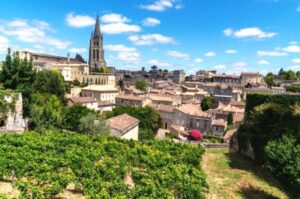
Saint-Émilion is a charming medieval village, perched on a promontory, located in the heart of the famous Bordeaux wine area. It is a unique site where world famous wineries produce fine wine, and together with beautiful architecture and great monuments, are a perfect match. We had visited this lovely village very briefly many years ago, and as we were based in Bordeaux for some days, it was the ideal opportunity to head to Saint-Émilion on the convenient local bus for the day.
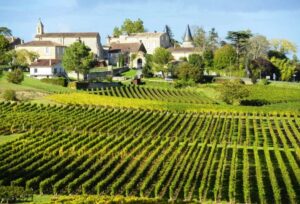
The first thing that springs to mind when you hear “Saint-Émilion” quite obviously would be wine. That in itself is worth the visit, but the town is a delight for lovers of history and architectural heritage. The narrow, sloping streets are lined with fine old houses, and there are many outstanding monuments scattered throughout the town. An added bonus is the lovely market held on Wednesday and Sunday mornings, with stalls taking over the cobblestones of the attractive central square.
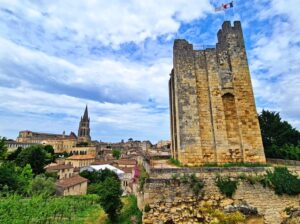
To further add to the town’s charms, its position affords stunning views, so it’s worth taking a walk up to see the Tour du Roi (King’s Tower, or Keep) on the western side of town. Of the original, grand château, the impressive square stone Keep is all that now remains. It rests on an isolated rocky massif, and dug into natural caves and quarries that operated in the early Middle Ages. The château dates back to the 13th century, and was an important component of the city’s defences. It’s the only Romanesque Keep still intact in the Gironde, thought to have been built in 1237 on the orders of the English King, Henry lll Plantagenet, who was also Duke of Aquitaine through his mother, Eleanor of Aquitaine, when Saint-Émilion fell once again under English control. The geopolitical landscape of the region shifted during this time, making it a significant chess piece in the complex game of European politics, and heralding centuries of tug-of-war between English and French sovereignty.
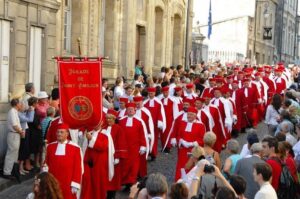
The Keep is an important site for the ‘Jurade’, a prestigious local organisation that is responsible for ensuring the quality of the Saint-Émilion wines, and promoting them around the world. The members of the Jurade celebrate the wines of Saint-Émilion twice a year with parades, which always finish at the top of the town at the Keep. From up here, there are great views over the town and the surrounding vineyards.
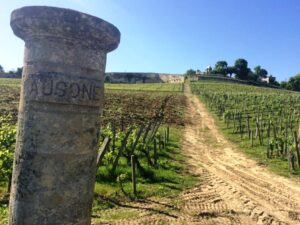
The history of Saint-Émilion goes back at least 35,000 years to the Upper Paleolithic era. An oppidum was built on the hill overlooking the present-day village in Gaulish times, before the region was annexed by Augustus in 27BCE. As early as the 2nd century, the Romans began clearing the local forests in the area in order to plant vines, and the Latin poet Decimus Magnus Ausonius lauded the fruit of these bountiful vines. Remains of the many Roman villas that were built during this time have been found all around Saint-Émilion.
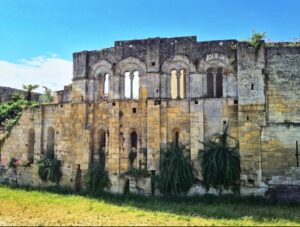
The rise of Christianity helped wine regions such as Saint-Émilion grow over the years. The name “Saint-Émilion” originates from an 8th century monk named Émilian, a monk from Brittany who fled from Vannes, his hometown, to seek refuge elsewhere. He settled in the village which was still called “Ascumbas” at the time, and worked firstly as a baker in a manor for a local aristocrat, and was well-known in the village for taking bread to the poor. He eventually left the manor and lived in a limestone cave as a hermit, accomplishing a number of miracles which rapidly made him famous in the region. He eventually founded the Hermitage of Saint-Émilion, carved from a rock shelter in a deserted forest. Émilian lived in the oratory until his death in 767. The monks who followed him started up commercial wine production in the area.
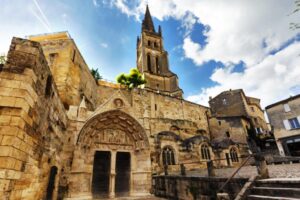
From the 9th–10th centuries, locals mined the area for limestone which was used in the construction of the village and surrounding area. The monolithic church of Saint-Émilion was dug out of the limestone in the early 12th century, originally as a cavity to keep the body of Saint-Émilion. The stonemasons gave this building the appearance of a church, divided into 3 naves, which were later decorated with fine frescoes and sculptures.
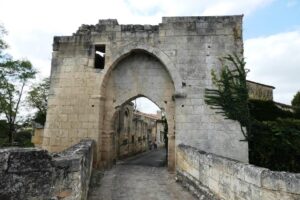
In the Middle Ages, Saint-Emilion was defended by fortified walls, built between 1110 and 1224 with 1,500 m. of crenellated ramparts. Six gateways, double the thickness of the walls, provided access to the town. One of these, Porte Brunet, opening onto the vineyards, is the only one of these gates still almost in its original condition. From here, the comings and goings throughout the Dordogne valley could be observed.
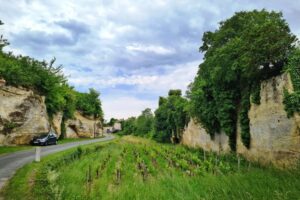
Running around the town wall is a road that was originally a long defensive ditch almost 1.50kms long, about 20m. wide and 8 to 10m deep. The name of this road today is rue des Douves, which means “moat”, although this ditch was never full of water. The local people had their gardens in it, and during the Middle Ages, it even served as an alternative route to serve the storage areas on the ground floor of the houses built against the perimeter wall. Wooden gang planks, withdrawn during times of war and upheaval, enabled people to go down into the ditch. From the 18th century, the ditch had no further defensive purpose and was used as a starting point to dig some of the many quarries that run under the town and outside it.
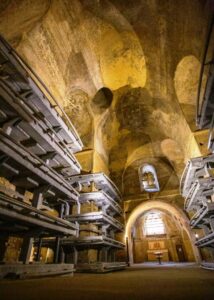
As a result, there is an astonishing 200kms of underground passages or galleries under the village and its vineyards that visitors can tour, which include the remains of the hermitage built by Émilion, the Chapel of the Trinity and its medieval paintings, and the surprising monolithic church of Saint-Émilion that’s the largest in Europe, and its catacombs.
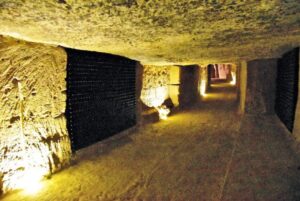
When the stone quarries were abandoned at the end of the 19th century, many galleries were converted for mushroom production, which were used up to the middle of the 20th century, while others were turned into wine cellars. Apparently, these underground galleries are perfect for storing wines because they keep temperatures at a constant 11-12 C. deg. Many of the older inhabitants of Saint-Émilion remember cycling through this enormous underground maze.
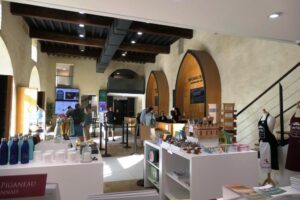
Tours of the underground heritage of Saint-Emilion take place throughout the day, and if you’d like to visit this remarkable site, head to the Saint-Émilion Tourism office in Place des Créneaux to sign up for a tour—they offer many different languages.
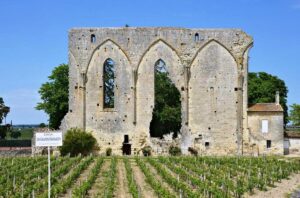
Because the region was located on the pilgrimage route to Santiago de Compostela, many monasteries and churches were built during the Middle Ages, and in 1199, while under Plantagenet rule, Saint-Émilion was granted full trading rights. During the 12th and 13th centuries, the wines produced in the area were renowned for their quality, although political instability during the Wars of Religion severely affected the vineyards. With Henry IV on the French throne from 1589, Saint-Émilion finally enjoyed a period of relative stability and a return to agricultural activities and vinicultural development. This was an era of improvement and refinement in the viticulture techniques that would eventually make the wines of Saint-Émilion world famous.
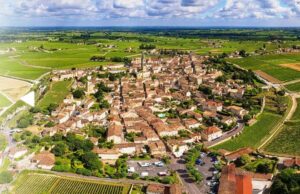
Even in the rural areas around Saint-Émilion, the violent tremors of the Revolution were felt. As revolutionary fervour spread throughout the country, many of the local inhabitants of the Saint-Émilion region fled, leaving the town vulnerable to looting and vandalism. This exodus and subsequent turmoil were a severe setback for the remaining community, but the turbulence laid the groundwork for radical changes within society. With the passage of time and the stabilisation of national government, Saint-Émilion would eventually recover and rebuild.
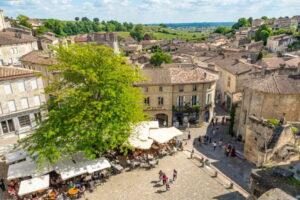
The region really only fully recovered in the late 19th century. As tastes and markets evolved and expanded, the wines from this region started capturing the attention of connoisseurs and non-expert wine lovers alike. This growing demand brought new life to the area, revitalising the vineyards and the town’s civic life, as well as its architecture. Today’s many châteaux that dot the landscape serve as monuments to this rise in prosperity.
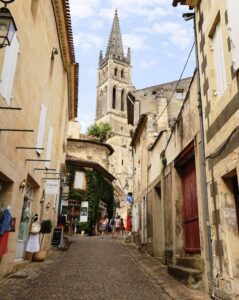
In 1999, Saint-Émilion was designated by UNESCO as a World Heritage Site, thus affirming the town’s extraordinary historical and cultural values and elevating its status on the global stage. As a result, tourism as increased along with international interest, making Saint-Émilion a must-visit for those keen on history as well as wine enthusiasts. Wine tourism has thrived, and the visitor experience improved. Visitors can experience first-hand the rich terroir and time-honoured traditions that make the local wines so special. Many vineyards offer wine tours, offering immersive experiences that range from walking among the rows of grapevines, to participating in tastings guided by expert sommeliers. Many prestigious châteaux that once symbolised 19th century prosperity are open to the public, offering a unique blend of fine architecture and modern winemaking techniques.
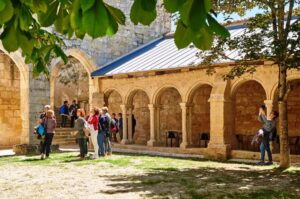
One of the most interesting things to visit in Saint-Émilion is right in the centre of town, the Cloister of the Cordeliers. Originally a monastery constructed in the 14th century by the order of Franciscan monks known as the “cordeliers”, because of the rope they wore around the waist of their robe. The monks led a quiet, peaceful existence, cultivating their vegetable gardens, constructing the Cloister as well as the cellar where they produced wine for their own consumption. Like many similar religious communities, during the Revolution, the monks were forced to abandon their Cloister and estate, and disperse.
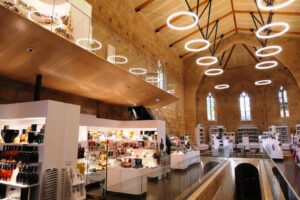
The Cloister remained abandoned until the 19th century when it was rehabilitated and restored by the Meynot family, who also restored the 3km underground galleries, in order to produce sparkling wine. Although this wine is produced according to the méthode champenoise, it cannot be called Champagne, since Saint-Emilion is outside the Champagne district.
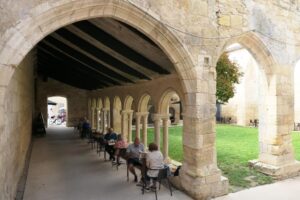
The Cloître des Cordeliers, as the estate is known, is open to visitors, and tastings of its sparkling wine are also offered on an hour’s tour which costs around 10 Euros, although access to the complex is free of charge. They also offer a tour of the extensive underground galleries and cellars by electric tuk-tuk, at a cost of 25 Euros. As well as the tours, they have a very good wine and gift boutique and an outdoor wine bar on site.
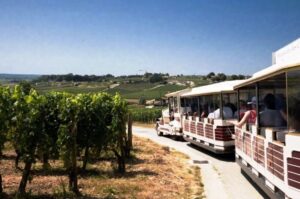
To experience a number of the vineyards, there’s a little tourist train that tours around some of them. You’ll see not only the vineyards at close quarters but some of the châteaux you’d be hard pressed to see otherwise. The ride costs around 7 Euros per person and takes around 40 mins. Head to the Tourist Office for details.
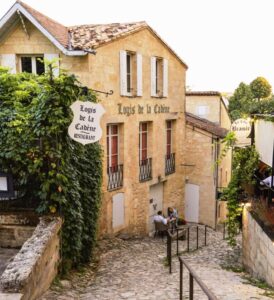
There’s a good choice of accommodation in Saint-Émilion, and needless to say, some very good restaurants and bistros serving excellent local produce and wines.

The town is also known for its macarons, which have been made there continuously since 1620. The original recipe has been passed down through generations by Ursuline nuns, who started making them as a fundraiser for their monastery, using a recipe they had acquired from Milan. Since coconut was such a rare and expensive ingredient, they substituted almonds, and so was created the now famous Saint-Émilion macaron. These macarons traditionnels are made from ground almonds, sugar and fresh egg whites. Buy a box to munch on the bus back to Bordeaux, or enjoy as a late night snack as you relax in your village hotel after a delightful day exploring beautiful Saint-Émilion.
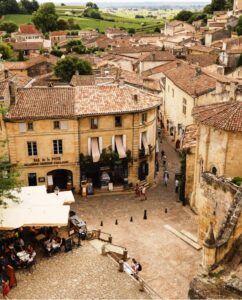

Diane Hogan
Love the history of Saint-Emilion, we’ve been there but did not see all the places you mentioned. I really loved the communal washing place.
Thank you again, Diane
Cheryl Brooks
Hi Diane,
Glad you enjoyed the story, and that it brought back some pleasant memories. I know what you mean about discovering all the sights of a destination. We’d been there before, but this time around, we saw things we hadn’t realised were there! I love that we can still find unknown treats, and never say we’ve seen it all.
Cheers, Cheryl
Anthony (Tony) Taggart
Hi Cheryl, just love the sound of the macarons! I can almost taste them.
What a wonderful place it is and you have described it so beautifully. Certainly in an area of great history.
Talk soon, love Annette and Tony Taggart
Cheryl Brooks
Hi Tony and Annette,
Delighted you enjoyed the story. Yes, St Emilion is a gem! So much fascinating history, but also the food..
Would love to catch up soon. Love, Cheryl (and Graham)